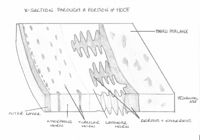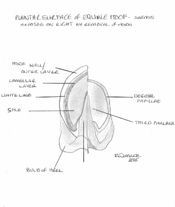Difference between revisions of "Hoof - Anatomy & Physiology"
| Line 7: | Line 7: | ||
}} | }} | ||
<br> | <br> | ||
| − | + | ==Introduction== | |
The keratin in the epidermis, when thickened and cornified, is referred to as [[Horn - Anatomy & Physiology|horn]]. Horn is particularly resistant to mechanical and chemical damage. The outer surface of the hoof is composed of horn. | The keratin in the epidermis, when thickened and cornified, is referred to as [[Horn - Anatomy & Physiology|horn]]. Horn is particularly resistant to mechanical and chemical damage. The outer surface of the hoof is composed of horn. | ||
Revision as of 14:14, 5 August 2008
|
|
Introduction
The keratin in the epidermis, when thickened and cornified, is referred to as horn. Horn is particularly resistant to mechanical and chemical damage. The outer surface of the hoof is composed of horn.
Structure and Function
Equine Hoof
The epidermis of the horny hoof is termed the coronary epidermis. Its surface has a plantar aspect and newly formed hoof grows distally towards the plantar surface of the structure. Hoof wall is generally 5 - 10 mm in thickness and consists of 3 layers:
- A thin outer layer or "wall" of shiny, dense horn, which effectively seals the hoof against dehydration and penetration.
- A thicker, intermediate layer of amorphorous horn, interspersed with tubular horn which provides reinforcement. This layer makes up the bulk of the hoof.
- An inner, lamellar layer, where epidermis and dermis interdigitate, anchoring the dead portion of the hoof to the living surface of the third phalanx.
The pigmentation in the outer layer of hooves is derived from melanocytes in the coronary epidermis. Deeper layers contain little melanin and therefore appear lightly coloured or white. The unpigmented layer of keratin forms a white line on the sole of the hoof, which delineates the sole from the wall when the plantar aspect is viewed.
The keratin in the sole is formed by the epidermis of the plantar aspect of the third phalanx and reaches a maximum thickness of 1 cm. It is less resistant to abrasion than that of the outer layer of the hoof. The central frog of the sole of a horse is located between the sharply inflected bars of the wall and is softer and less rigid than the keratin of the wall of the hoof. Its elasticity is particulary important in the horse as pressure on the frog changes the angle of the walls when the horse stands on that foot. The change in angle, termed the hoof mechanism increases the blood circulation in the hoof, increasing the supply of nutrients to the coronary epidermis. This is closely correlated to hoof wall quality.
A band of soft, pliable horn termed the periople (analagous with the cuticle of human nails) lies over the proximal outer surface of the wall. This band widens at the back of the hoof to also cover the bulbs of the heels and part of the frog.
Ruminant Hoof
Although the hooves of these species resemble the equine hoof, they differ in several ways:
- There are two separate main digits, compared with the single hoof of equids
- The wall is bent to form a dorsal border
- The bulb of the heel covers the entire caudal surface of the hoof and most of the plantar surface, leaving a small area of sole visible
- The interdigitating lamellae are smaller and less well developed.
The hooves of the main digits curve medially towards each other. The lateral digit carries more weight than the medial digit, and is larger. On the abaxial wall, the distal border makes contact with the ground along its entire length, whereas, on the axial wall, only does so toward the toe. The thickness of the wall increases towards the apex and the plantar surface.
The horn of the hoof generally grows at a rate of 5 mm per month, and cattle allowed to move freely, growth should equal wear. In intensively kept cattle, growth exceeds wear, and foot trimming is required to maintain optimal shape and angle. The optimal angle of the toe from the ground is 50 degrees.
Dewclaws are present in most ruminants but do not make contact with the ground. They consist of wall and bulb and have no practical importance.
Porcine Hoof
The hooves of pigs are principally similar to those of ruminants, however the wall is straight, not bent medially at the toe, and have a soft bulb that is well distanced from the wall and sole. The hooves of the accessory digits are of the same structure as the principal digits, but only bear weight on soft ground.
Hoof trimming in pigs is rarely required due to the short lifespan of the farmed pig.

